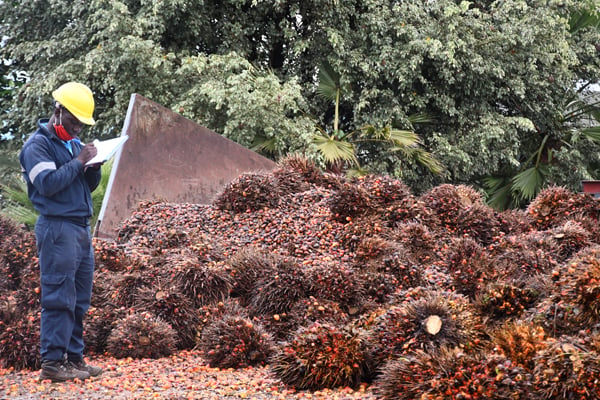Farmers count profits from palm oil fruits

A clerk takes notes of delivered stock at one of the factories in Kalangala. Each factory can process 20 metric tonnes of crude oil per hour. Photo/Edgar R. Batte
What you need to know:
- IFAD designed this project in response to a government request for support in developing national vegetable oil production to decrease the country’s dependence on imported oil.
More than 5,000 farmers are engaged in palm oil farming on 11,000 hectares of land in Kalangala, a crop that is offering commercial returns to farmers.
James Lutaaya, a resident of Busanga, is a former coffee farmer whose dwindling fortunes forced him to switch to palm oil in 1991 at its introduction by the Government of Uganda and International Fund for Agricultural Development (IFAD) under a public-private partnership (PPP).
Pilot project
For a long time, Kalangala was known for fishing and fish trade as a source of livelihood. In 1989, when it was carved out of the greater Masaka District, oil palm was identified as a potential commercial crop and duly adopted by locals.
IFAD designed this project in response to a government request for support in developing national vegetable oil production to decrease the country’s dependence on imported oil.
Lutaaya was among 60 farmers that got engaged in the pilot agricultural project. He started with 62 acres of the crop whose commercial rewards have enabled him to build a new home and equitably share out the acreage among his nine children.
Benefits
Thanks to the sales and making a profit from the crop on the Kalangala Palm Oil project, he has been able to educate his children up to institutions of higher learning.
He is giving them what he never achieved. He was only able to study up to Primary Seven. “I have been the chairperson of palm farmers for 17 years. Government gave me a car that we used to survey the crop,” Lutaaya explains.
Other crops
He reserved seven acres for food security. He also grows coffee, maize, food and keeps animals. To make sense of the farming venture, he learnt and has been practising preparing a nursery, application of fertiliser, weeding, disease control, harvest and more.
At harvest time, Lutaaya engages the services of 28-year-old William Masereka, a casual worker who harvests the crop. Mature palms are single-stemmed and grow to 20 metres or 66 feet tall.
The clusters of fruit from the oil palms grow up close to the leaves of the tree. A ripe and semi- sharp-ended cluster can weigh up to 50 kilogrammes so Masereka will need to take care as he chisels to cut the cluster using a long-armed sickle.
Lutaaya pays him Shs18,000 per tonne of harvest. At his level, Masereka earns from the crop without necessarily farming it. “I have been able to save, over time, to buy a plot of land worth Shs3m and build a house. I have also been able to buy a boda boda (commercial motorcycle),” he explains.
Prices
Lutaaya sold a kilogramme of fresh fruit at Shs869 last month. It cost Shs857 in April. David Mukasa Balironda, general manager of The Registered Trustees of Kalangala Oil Palm Growers Trust (KOPGT), says the national pricing committee sits every month. It is chaired by the minister of Agriculture. It is composed of representatives from the ministry of Trade, farmers, the oil company and Kalangala District Local Government.
Value addition
An oil palm tree bears fruit at four years and if well nurtured, is able to be harvested at least thrice a month thereafter. Production of palm oil started in 2010.
There are two factories in Kalangala, each with a production capacity of 20 metric tonnes of crude oil per hour. Mukasa, the brainchild of the project, says that the factories are not yet operating to full capacity.
They are operating at 70 per cent which has been registered as a success. The crude oil is transported for value addition to Jinja for refinery at Bidco Uganda Limited, manufacturers of cooking oil products, fats, baking powder, margarine and soap.
Businessman John Freeman Kiyimba trades in the finished products of the factory. He undertook distributorship in 2003. “The company gave me one-year targets but I was able to achieve them within six months. I was given the responsibility of distributing the items for Bidco in the central region,” he explains.
Mukasa says that the oil palm project has reported dividends of Shs17.7b and remitted taxes of Shs2.6b over the period of 10 years. The Kalangala Palm Oil Project is the brainchild of Kalangala District Local Government.
Outgrowers have planted 4, 828 hectares. On every acre, an average of 58 trees. Kodey Rao, managing director of Bidco projects that within the next five years, the total area under palm tree coverage will be about 40,000 hectares.
Value addition
An oil palm tree bears fruit at four years and if well nurtured, is able to be harvested at least thrice a month thereafter. Production of palm oil started in 2010.
There are two factories in Kalangala, each with a production capacity of 20 metric tonnes of crude oil per hour. Mukasa, the brainchild of the project, says that the factories are not yet operating to full capacity.





